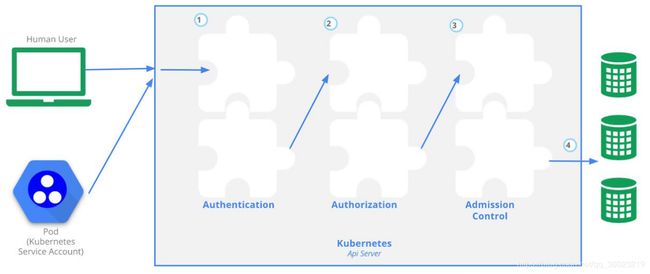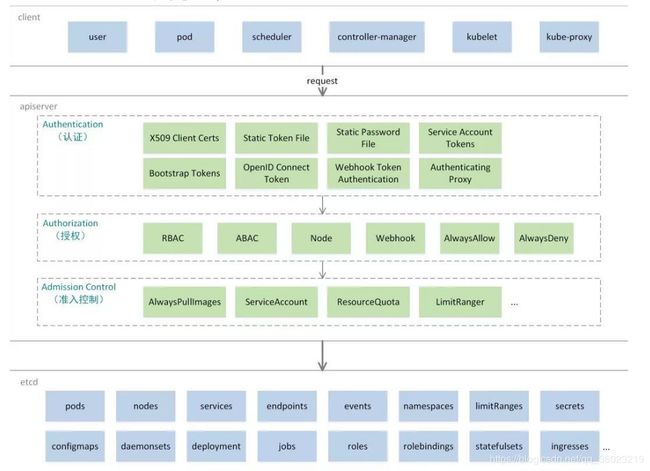Kubernetes访问控制
Kubernetes访问控制
kubernetes API 访问控制
Authentication(认证)
- 认证方式现共有8种,可以启用一种或多种认证方式,只要有一种认证方式通过,就不再进行其它方式的认证。通常启用X509 Client Certs和Service Accout Tokens两种认证方式。
- Kubernetes集群有两类用户:由Kubernetes管理的Service Accounts (服务账户)和(Users Accounts) 普通账户。k8s中账号的概念不是我们理解的账号,它并不真的存在,它只是形式上存在。
Authorization(授权)
- 必须经过认证阶段,才到授权请求,根据所有授权策略匹配请求资源属性,决定允许或拒绝请求。授权方式现共有6种,AlwaysDeny、AlwaysAllow、ABAC、RBAC、Webhook、Node。默认集群强制开启RBAC。
Admission Control(准入控制)
- 用于拦截请求的一种方式,运行在认证、授权之后,是权限认证链上的最后一环,对请求API资源对象进行修改和校验。
访问k8s的API Server的客户端主要分为两类:
- kubectl :用户家目录中的 .kube/config 里面保存了客户端访问API Server的密钥相关信息,这样当用kubectl访问k8s时,它就会自动读取该配置文件,向API Server发起认证,然后完成操作请求。
- pod:Pod中的进程需要访问API Server,如果是人去访问或编写的脚本去访问,这类访问使用的账号为:UserAccount;而Pod自身去连接API Server时,使用的账号是:ServiceAccount,生产中后者使用居多。
kubectl向apiserver发起的命令,采用的是http方式,其实就是对URL发起增删改查的操作。
kubectl proxy --port=8888 &
curl http://localhost:8888/api/v1/namespaces/default
curl http://localhost:8888/apis/apps/v1/namespaces/default/deployments以上两种api的区别是:
- api它是一个特殊链接,只有在核心v1群组中的对象才能使用。
- apis 它是一般API访问的入口固定格式名。
UserAccount与serviceaccount:
- 用户账户是针对人而言的。 服务账户是针对运行在 pod 中的进程而言的。
- 用户账户是全局性的。 其名称在集群各 namespace 中都是全局唯一的,未来的用户资源不会做 namespace 隔离, 服务账户是 namespace 隔离的。
- 通常情况下,集群的用户账户可能会从企业数据库进行同步,其创建需要特殊权限,并且涉及到复杂的业务流程。 服务账户创建的目的是为了更轻量,允许集群用户为了具体的任务创建服务账户 ( 即权限最小化原则 )。
创建serviceaccount:
kubectl create serviceaccount adminkubectl describe sa admin ##此时k8s为用户自动生成认证信息,但没有授权添加secrets到serviceaccount中
kubectl patch serviceaccount admin -p '{"imagePullSecrets": [{"name":
"myregistrykey"}]}'把serviceaccount和pod绑定起来:
apiVersion: v1
kind: Pod
metadata:
name: myapp
labels:
app: myapp
spec:
containers:
- name: myapp
image: reg.harbor.com/library/game2048
ports:
- name: http
containerPort: 80
serviceAccountName: admin将认证信息添加到serviceAccount中,要比直接在Pod指定imagePullSecrets要安全很多。
创建UserAccount:
cd /etc/kubernetes/pki/
openssl genrsa -out test.key 2048
openssl req -new -key test.key -out test.csr -subj "/CN=test"
openssl x509 -req -in test.csr -CA ca.crt -CAkey ca.key -CAcreateserial -out test.crt -days 365
openssl x509 -in test.crt -text -noout
kubectl config set-credentials test --client-certificate=/etc/kubernetes/pki/test.crt --client-key=/etc/kubernetes/pki/test.key --embed-certs=true
kubectl config view
kubectl config set-context test@kubernetes --cluster=kubernetes --user=test
kubectl config use-context test@kubernetes
kubectl get pod此时用户通过认证,但还没有权限操作集群资源,需要继续添加授权。
RBAC(Role Based Access Control):基于角色访问控制授权
- 允许管理员通过Kubernetes API动态配置授权策略。RBAC就是用户通过角色与权限进行关联。
- RBAC只有授权,没有拒绝授权,所以只需要定义允许该用户做什么即可。
- RBAC包括四种类型:Role、ClusterRole、RoleBinding、ClusterRoleBinding。
RBAC的三个基本概念 :
- Subject:被作用者,它表示k8s中的三类主体, user, group, serviceAccount
- Role:角色,它其实是一组规则,定义了一组对 Kubernetes API 对象的操作权限。
- RoleBinding:定义了“被作用者”和“角色”的绑定关系。
Role 和 ClusterRole
- Role是一系列的权限的集合,Role只能授予单个namespace 中资源的访问权限。
- ClusterRole 跟 Role 类似,但是可以在集群中全局使用。
Role示例
kind: Role
apiVersion: rbac.authorization.k8s.io/v1
metadata:
namespace: default
name: myrole
rules:
- apiGroups: [""]
resources: ["pods"]
verbs: ["get", "watch", "list", "create", "update", "patch", "delete"]
RoleBinding 和 ClusterRoleBinding
- RoleBinding是将Role中定义的权限授予给用户或用户组。它包含一个subjects列表(users,groups ,service accounts),并引用该Role。
- RoleBinding是对某个namespace 内授权,ClusterRoleBinding适用在集群范围内使用。
RoleBinding示例:
kind: RoleBinding
apiVersion: rbac.authorization.k8s.io/v1
metadata:
name: test-read-pods
namespace: default
subjects:
- kind: User
name: test
apiGroup: rbac.authorization.k8s.io
roleRef:
kind: Role
name: myrole
apiGroup: rbac.authorization.k8s.ioClusterRole示例
kind: ClusterRole
apiVersion: rbac.authorization.k8s.io/v1
metadata:
name: myclusterrole
rules:
- apiGroups: [""]
resources: ["pods"]
verbs: ["get", "watch", "list", "delete", "create", "update"]
- apiGroups: ["extensions", "apps"]
resources: ["deployments"]
verbs: ["get", "list", "watch", "create", "update", "patch", "delete"]
使用rolebinding绑定clusterRole:
apiVersion: rbac.authorization.k8s.io/v1
kind: RoleBinding
metadata:
name: rolebind-myclusterrole
namespace: default
roleRef:
apiGroup: rbac.authorization.k8s.io
kind: ClusterRole
name: myclusterrole
subjects:
- apiGroup: rbac.authorization.k8s.io
kind: User
name: test
创建clusterrolebinding:
apiVersion: rbac.authorization.k8s.io/v1
kind: ClusterRoleBinding
metadata:
name: clusterrolebinding-myclusterrole
roleRef:
apiGroup: rbac.authorization.k8s.io
kind: ClusterRole
name: myclusterrole
subjects:
- apiGroup: rbac.authorization.k8s.io
kind: User
name: test
服务账户的自动化
服务账户准入控制器(Service account admission controller)
- 如果该 pod 没有 ServiceAccount 设置,将其 ServiceAccount 设为 default。
- 保证 pod 所关联的 ServiceAccount 存在,否则拒绝该 pod。
- 如果 pod 不包含 ImagePullSecrets 设置,那么 将 ServiceAccount 中的ImagePullSecrets 信息添加到 pod 中。
- 将一个包含用于 API 访问的 token 的 volume 添加到 pod 中。
- 将挂载于 /var/run/secrets/kubernetes.io/serviceaccount 的 volumeSource 添加到pod 下的每个容器中。
Token 控制器(Token controller)
- 检测服务账户的创建,并且创建相应的 Secret 以支持 API 访问。
- 检测服务账户的删除,并且删除所有相应的服务账户 Token Secret。
- 检测 Secret 的增加,保证相应的服务账户存在,如有需要,为 Secret 增加 token。
- 检测 Secret 的删除,如有需要,从相应的服务账户中移除引用。
服务账户控制器(Service account controller)
- 服务账户管理器管理各命名空间下的服务账户,并且保证每个活跃的命名空间下存在一个名为 “default” 的服务账户
Kubernetes 还拥有“用户组”(Group)的概念:
- ServiceAccount对应内置“用户”的名字是: system:serviceaccount:
- 用户组所对应的内置名字是: system:serviceaccounts:
示例:
1. 表示mynamespace中的所有ServiceAccount
subjects:
- kind: Group
name: system:serviceaccounts:mynamespace
apiGroup: rbac.authorization.k8s.io2. 表示整个系统中的所有ServiceAccount
subjects:
- kind: Group
name: system:serviceaccounts
apiGroup: rbac.authorization.k8s.io
Kubernetes 还提供了四个预先定义好的 ClusterRole 来供用户直接使用:
- cluster-amdin
- admin
- edit
- view
示例:
kind: RoleBinding
apiVersion: rbac.authorization.k8s.io/v1
metadata:
name: readonly-default
subjects:
- kind: ServiceAccount
name: default
namespace: default
roleRef:
kind: ClusterRole
name: view
apiGroup: rbac.authorization.k8s.io


